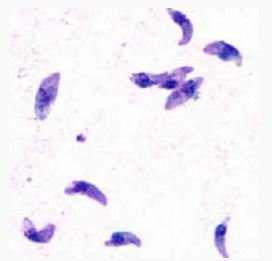Toxoplasmosis is an infection caused by a single-celled parasite called Toxoplasma gondii. It is prevalent worldwide and can persist in the body for a long time, potentially even for a lifetime.
While most healthy individuals with a good immune system do not experience any symptoms, pregnant women and those with compromised immune systems should be cautious, as infection could lead to serious health complications.
Toxoplasmosis can be transmitted through various means, including eating contaminated food, exposure to infected cat feces, and rare transmission routes such as organ transplants and blood transfusions.
Causes and Transmission of Toxoplasmosis
Eating undercooked food
Toxoplasmosis can be contracted by eating undercooked meat, particularly pork, lamb, or venison. It can also be spread through unwashed fruits and vegetables, contaminated water, and dirty cat-litter boxes. Ingesting contaminated cat feces can occur if hands touch the mouth after gardening, cleaning a litter box, or touching anything that comes in contact with cat feces. About 50% of toxoplasmosis infections in the U.S. each year are acquired from food. It’s important to cook meat thoroughly, washing all fruits and vegetables, and washing hands with soap and warm water after handling raw meat.
Exposure to infected cat feces
Tooplasmosis can also be contracted through exposure to infected cat feces. Cats are the primary host for the parasite, and they can shed the infectious form of the parasite in their feces for up to two weeks after being infected. The parasite can contaminate soil, water, fruits and vegetables, litter boxes, and other surfaces where cats have defecated. To protect oneself from exposure to infected cat feces, it is recommended to avoid changing litter boxes when pregnant or with a weakened immune system, wear disposable gloves when handling litter, and wash hands thoroughly with soap and water afterwards.
Mother to child transmission
Toxoplasmosis can be transmitted from an infected pregnant woman to her unborn baby through the placenta. According to a study published on PubMed, the overall maternal-fetal transmission rate is 29%, with a sharp increase in risk occurring after 13 weeks of gestation and up to 72% at 36 weeks. Infected fetuses in early pregnancy are more likely to show clinical signs of infection, which can lead to long-term complications. Pregnant women who acquire toxoplasmosis require counselling about the risk of congenital infection and its clinical sequelae to guide their decision-making on investigative and therapeutic options.
Rare transmission routes
Although toxoplasmosis is primarily transmitted through ingestion of contaminated food and cat feces, there are rare transmission routes as well. One such route is through organ transplantation from an infected donor. Blood transfusion from an infected donor can also transmit the parasite, although this is very rare. In addition, toxoplasmosis can be spread through contaminated soil or water. It is important to note that these transmission routes are not common, and the majority of cases are caused by consumption of undercooked meat or exposure to cat feces.
Symptoms of Toxoplasmosis
Asymptomatic cases in healthy adults
Toxoplasmosis is a common parasitic disease, and an estimated one-third of the world’s population is infected. Although the most common form of the disease is asymptomatic, recent research has shown that latent toxoplasmosis can play a role in the development of various mental disorders, including schizophrenia and depressive disorders. Asymptomatic cases in healthy adults are common, accounting for approximately 90% of infections among immunocompetent persons. These cases are usually self-limiting or nonspecific, and physicians may have low awareness and clinical suspicion of toxoplasmosis, resulting in missed opportunities for diagnosis and case identification.
Flu-like symptoms
Flu-like symptoms are common in individuals infected with Toxoplasmosis. The symptoms generally appear after a few weeks of infection and include fever, body ache, sore throat, and swollen lymph nodes. In most cases, the symptoms are mild and go away without any treatment. However, in some cases, the symptoms can be severe, especially in immunocompromised individuals. They may experience confusion, seizures, and headaches. It is advisable to seek medical attention if the symptoms persist or worsen over time. Early detection and treatment can help reduce the severity of symptoms and prevent complications.
Severe symptoms in immunocompromised individuals
Severe symptoms of toxoplasmosis are more likely to occur in people with weakened immune systems, such as those with HIV/AIDS or undergoing chemotherapy. The parasite can affect the brain, causing symptoms such as headaches, confusion, seizures, and even coma. Other symptoms may include high fever, severe muscle pain, and lung problems. Without treatment, severe cases of toxoplasmosis in immunocompromised individuals can be life-threatening. However, prompt diagnosis and treatment with antibiotics can help reduce the severity of symptoms and prevent complications.
Eye problems
Eye problems are a common symptom of toxoplasmosis, particularly in cases of ocular toxoplasmosis. This condition can cause inflammation in the back of the eye, leading to blurred vision, eye pain, and sensitivity to light. In some cases, it can even result in blindness if left untreated. Babies born with congenital toxoplasmosis can also develop eye problems, including cataracts and damage to the retina. To prevent the transmission of toxoplasmosis and its associated eye problems, it’s important to practice good hygiene, avoid consuming undercooked meats, and wear gloves when handling cat litter or gardening.
How toxoplasmosis is detected
Toxoplasmosis is detected through a series of diagnostic tests, which include blood tests and other imaging methods. A doctor may conduct the following tests based on your symptoms and medical condition:
- Blood test: It detects the presence of two types of antibodies in the body.
- MRI or CT scans: These imaging tests are used to create images of the brain. They can detect irregular structures in the brain related to toxoplasmosis.
- Eye exam: If you have eye symptoms, you will need an exam by a doctor who specializes in eye disease. An exam may include special lenses or cameras to see tissues inside the eye.
- Genetic testing: This testing can help identify the type of parasite causing the infection.
- Other tests: Depending on other symptoms and health factors, other tests may be recommended.
Regular and frequent follow-up appointments are needed, especially to watch for side effects, vision problems, and physical, intellectual, and overall development. Early detection and treatment of toxoplasmosis can prevent severe complications.
Treatment Options
The treatment options for toxoplasmosis include medications and ongoing monitoring. Here’s a guide to the different treatment methods:
- Medications: Pyrimethamine is the most effective drug against toxoplasmosis. Sulfadiazine or clindamycin are also included in the treatment. The fixed combination of trimethoprim with sulfamethoxazole and other drugs like atovaquone and pyrimethamine plus azithromycin can also be used in some cases.
- Follow-up Care: Patients should be monitored for 4 to 6 weeks during treatment, followed by reevaluation of their condition.
- Ocular Toxoplasmosis: Treatment for ocular diseases is based on a complete ophthalmologic evaluation. The decision to treat ocular disease is dependent on numerous parameters including acuteness of the lesion degree if inflammation visual acuity and lesion size location and persistence. Healed lesions should not be treated.
- Immunocompetent Adults: Treatment is rarely indicated for this group. If visceral disease is clinically evident or symptoms are severe or persistent, treatment may be indicated for 2 to 4 weeks.
Remember that treatment plans should be tailored to each individual based on their specific needs and history.
Prevention Methods
To prevent the risk of toxoplasmosis, it is important to follow certain guidelines:
- Cook food to safe temperatures using a food thermometer. For meat, cook to at least 145°F (63°C) for whole cuts of meat (excluding poultry) and 160°F (71°C) for ground meats. For poultry, cook to at least 165°F (74°C) in the innermost part of the thigh, innermost part of the wing, and thickest part of the breast.
- Freeze meat for several days at subzero temperatures before cooking.
- Peel or wash fruits and vegetables thoroughly before eating and wash utensils, cutting boards, dishes, and counters with soapy water after contact with raw meat or unwashed fruits and vegetables.
- Wear gloves when gardening or during any contact with soil or sand that might be contaminated with cat feces. Wash hands with soap and water after gardening or contact with soil or sand.
- Feed cats only canned or dried commercial food or well-cooked table food, not raw or undercooked meats, and change the cat litter box daily.
- Keep cats indoors to prevent them from hunting, and avoid adopting or handling stray cats or kittens.
By following these guidelines, you can greatly reduce your risk of toxoplasmosis.







